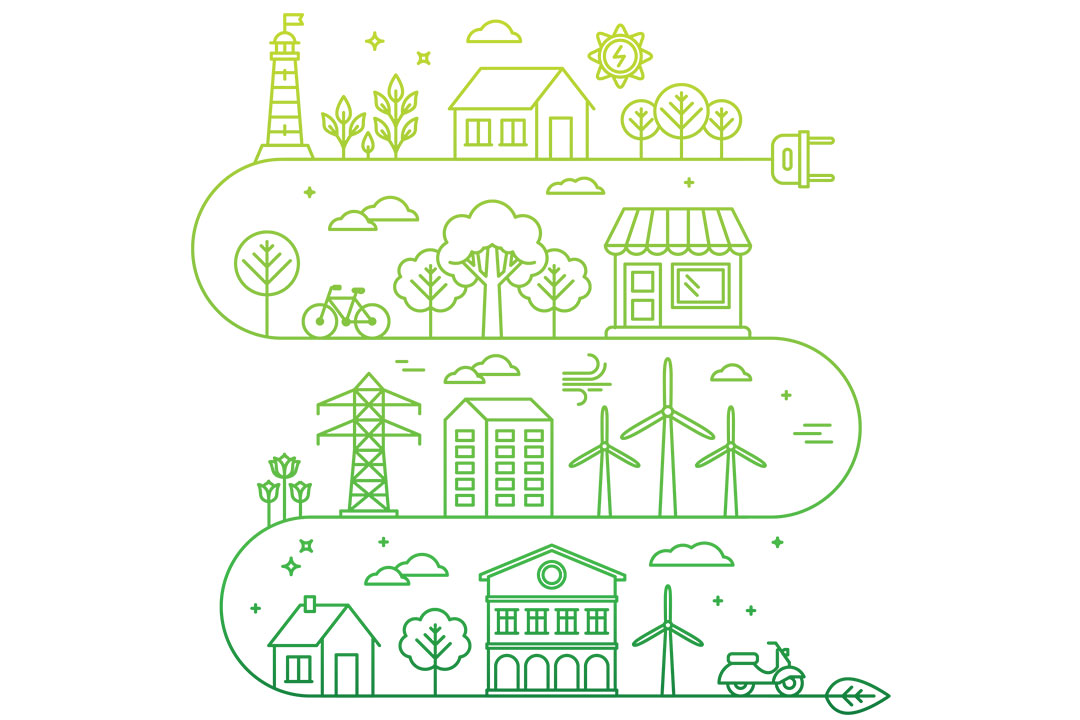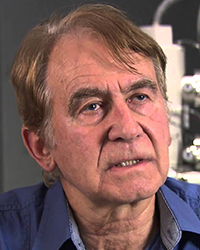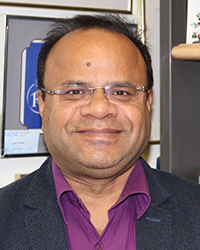
Powerful possibilities
Weaning the world from its fossil fuel addiction is a mammoth task that not only includes coming up with new ways to generate energy, but also storing it and transforming it for society’s needs, from smart phones, toasters and steel smelters to scooters, cars, trucks and trains.
By Michael Robin and HenryTye Glazebrook
Tim Kelly’s strategy is to go directly to the energy source that powers all life on Earth: the sun.
Kelly holds the Canada Research Chair in Photovoltaics in the Department of Chemistry at the University of Saskatchewan. He said solar energy has its limitations, as his father found out when he bought a small solar panel for the family cabin in Newfoundland. The idea was to use it to charge a battery pack to run the radio.
“He gives me a call once he gets back from the trip and says, ‘Hey Tim, these solar cells, they don’t work. It took forever to charge anything,’” Kelly recounted. “I said, ‘OK Dad, you’re in St. John’s. The prevailing weather pattern is rain, drizzle and fog.’”
Newfoundland may not be ideal for solar, but it’s a different story on the Prairies.
“The average installation in southern Saskatchewan or southern Alberta is as good as it gets anywhere in Canada,” Kelly said, explaining sunshine should be seen as another resource, like agri- culture, uranium and potash.
Kelly does provide caveats. For instance, it would be quite difficult for the average city dweller to go completely off-grid with a few rooftop solar panels.
“They can significantly offset your consumption,” he said, but to really make a difference a home needs to be optimized to conserve energy, with things like low-draw lighting and appliances, especially ovens, refrigerators and laundry equipment.
Then there’s the cost. While the price of solar has come down significantly, Kelly said average home installations can cost $10,000 or more. This means incentives such as rebates need to be in place.
“When you’re trying to argue with a homeowner, ‘I know you really want that nice kitchen renovation, but why don’t you put this solar panel on your roof instead?’” Kelly said. “The new islands in the kitchen tend to win that emotional battle.”
Another challenge is large solar farms covering significant areas— ideally on marginal lands or desert—are needed to produce the megawatts used by public utilities. But Kelly said it is still well worth pursuing.
“It’s an interconnected web, and solar can be one part of the solution,” Kelly said. “It can be a huge percentage of your overall grid needs.”
Caution to the wind

Solar is an intermittent power source, cycling with day and night and with cloud cover that causes spikes in output. This is also an issue with wind power. Researcher Rajesh Karki evaluates the reliability and cost of incorporating wind and solar energy into the power grid.
Both physical and economic factors drive wind power, said Karki, a professor in the Department of Electrical and Computer Engineering.
Ideally, turbines should be in locations with different wind conditions, so when one area is calm, wind is blowing in another. But the owners of wind turbines are paid by how much energy their machines can put into the grid, so they generally build where the best wind resources can be found. In Saskatchewan, this is largely in the southwest corner of the province.
“Most of the existing wind turbines are in one region, so that creates a problem of all turbines being affected by the same wind regime,” Karki explained.
Another restraint is turbine design, which Karki said is optimized for coastal areas. Such turbines need wind speeds of 45 kilometres per hour (kph) to produce their rated power output. Lubricants are also not designed for Canadian winters, stiffening up and stopping the turbines at temperatures of -20C and below. Icing, which changes the aerodynamic shape of turbine blades, is another major concern.
“The problem in Saskatchewan is when the demand is high, it’s usually on a very cold day,” Karki said. “If you’ve got a lot of wind power, say for example—(proponents) are talking about 50 per cent dependence on wind—then we would be out of power on a very cold winter evening.”
Turbines that can harvest lower wind speeds and are able to operate at colder temperatures are needed. As well, Karki explained that connecting Canada’s power grid better would allow for more use of wind power.
“The wind is always blowing somewhere,” he said.
Price to be paid
The Achilles’ heel of wind and solar and other renewables is intermittency—generating everything from excessive power to nothing at all, depending on the vagaries of time, weather and season. This is where another of Karki’s research areas— energy storage—comes in.
“This is a huge amount of energy, so just battery energy storage alone is not practical or feasible,” he said.
Karki is looking at strategies such as compressed air stored in underground reservoirs and massive flywheels that store energy as momentum.
But what all options have in common is cost: extra infra- structure and operating margins required by renewables including solar panels, wind turbines and grid-scale storage.
“If you look at the price of electricity in Europe … because they have invested a lot more in renewables, they’re paying maybe between two and three times what we pay here,” Karki said.
Pieces of the puzzle

Cheap and abundant, fossil fuels are most tempting to the developing world. While the developed world can afford the latest new LED lights, energy efficient appliances and electric cars, the poorest countries cannot.
“With wind and solar, these methods of electricity generation are much more expensive than coal,” said Jerzy Szpunar, Canada Research Chair of Advanced Materials for Clean Energy and a professor of mechanical engineering at the U of S. “We like clean energy, say wind for instance, but one has to realize that wind is not always blowing.”
Szpunar said that even with alternatives to fossil fuels being aggressively pursued to combat climate change—including carbon capture, solar, wind, geothermal, tidal and nuclear—mainstays such as coal remain “to this day, and probably for a long time, a major resource for the production of electricity.”
Unlike other low-emission sources of energy, nuclear power faces major hurdles such as funding and public perception.
France gets more than 75 per cent of its electricity from nuclear, but is not seen as green energy. Germany is lauded for its aggressive Energiewende wind and solar program that by some estimates supplies about 30 per cent of the country’s electricity. But since abandoning nuclear energy, Germany now burns far more coal from one of the largest strip mines on Earth.
“I think France considers it good business,” Szpunar said. “They are not only supplying so much of their electrical energy through nuclear power, they are also selling electricity—and quite a lot of it. They developed a very good reactor and they are also exporting many of them throughout the world. That is also a very good business for them.”
What a waste
Probably the biggest hurdle facing nuclear power is that of waste.
“At present, all of the countries that rely on nuclear energy store the byproducts temporarily,” Szpunar said. “They are expecting that the storage will be decided later on.”
He explained that there are some options for re-processing nuclear waste. “In France they recycle the waste, which does not mean they don’t need to store any materials, but just that the amount is minimized,” he said. “As a result, the amount of radioactive materials which have to be stored for a very long time is smaller than in the states, for instance, where there is no option for re-processed fuel.”
New technological options, such as a liquid salt reactor, could help to further reduce the amount of waste by-products.
“In the future, if these kinds of new reactor designs were implemented, then the amount of material which would have to be stored would be minimized probably by up to one thousand times less than at present,” he said.
Szpunar added that options typically viewed as eco-friendly, such and wind and solar power, have their own setbacks that have prevented them from being more widely implemented.
“When the wind isn’t blowing, the utility companies have to be ready to replace it with some other form of energy,” he said. “That can change, a lot, the price and cleanliness of clean energy. If that replacement is made using a coal plant, then that plant can’t be started all at once. They have to be running on low power, and running on low power creates almost as much pollution as high power.”
The bottom line, he stressed, is that all energy technologies have pros and cons, but society cannot afford to discard one out of hand because of a perceived challenge.
Power to move

One of the great advantages of fossil fuels is portability. While electric cars have made inroads, nothing beats petroleum when it comes to moving mass commodities and products over long distances.
“How do you get your trucks running and planes flying?” asked Ajay Dalai, Canada Research Chair in Bioenergy and Environmentally Friendly Chemical Processing. “You need jet fuel and you need diesel fuel.”
Dalai and his team are working to challenge fossil fuel dominance.
“I believe no matter what you do, you still need liquid fuel from renewable sources,” he said.
One of Dalai’s and colleague Hui Wang’s patented processes uses a catalyst to turn methane and carbon dioxide—two abundant waste products—into synthesis gas or “syngas,” a versatile feedstock used to produce everything from plastics to jet fuel, diesel fuel and gasoline.
Dalai explains methane can come from different sources. It’s routinely burned as waste when it occurs in oil wells and is also produced when organic matter breaks down, for example, in landfills. Since it’s about 25 times more potent than carbon dioxide as a greenhouse gas, it makes sense to not just let it escape into the atmosphere.
Carbon dioxide can also be a waste product from coal-fired power plants and is as a byproduct from fermentation used to create fuel ethanol. One Ontario company has licensed Dalai and Wang’s technology and is working to scale it up, using methane from biomass and carbon dioxide from an ethanol plant.
Dalai explained his group’s focus has shifted away from simply publishing papers—he has put his name to more than 400—to patents. These cover strategies to boost efficiency in ethanol and vegetable-based diesel production, and scrub mercury and carbon monoxide from power plant flue gases.
“We’re getting patents to move this (knowledge) into industrial partners’ hands as soon as possible,” he said.
Weaning the world from its fossil fuel addiction may not yield to a single solution, but to diverse ideas from many experts, borne of research, innovation, and political will.

